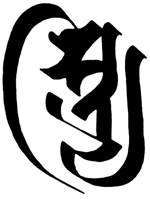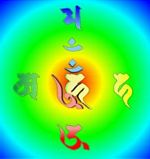Stryi and the Karaṇḍamudrā Dhāraṇī
 Back in Feb 2009 I was intrigued by a complex seed-syllable seen carved on the side of a Japanese stūpa. I could see the Siddhaṃ elements but wanted to understand the context. Eventually, with a little luck, I managed to identify the bīja as stryi which is associated with an important Japanese liturgical text: the Karaṇḍamudrā Dhāraṇī. I put some notes into this blog, but have now put this material on its own page: Karaṇḍamudrā Dhāraṇī and stryi.
Back in Feb 2009 I was intrigued by a complex seed-syllable seen carved on the side of a Japanese stūpa. I could see the Siddhaṃ elements but wanted to understand the context. Eventually, with a little luck, I managed to identify the bīja as stryi which is associated with an important Japanese liturgical text: the Karaṇḍamudrā Dhāraṇī. I put some notes into this blog, but have now put this material on its own page: Karaṇḍamudrā Dhāraṇī and stryi.At some point I want to do some Siddhaṃ calligraphy of the dhāraṇī itself, but here at least you can see where the syllable stryi originates from.
Some other versions of stryi can be seen in this Flickr Gallery: Stone Siddhaṃ.

 'GBH' asked
'GBH' asked  Compare with my pen style 'a' (left, and
Compare with my pen style 'a' (left, and 
 Doug wrote recently to ask about the association of the bīja
Doug wrote recently to ask about the association of the bīja 



